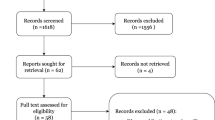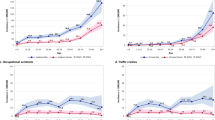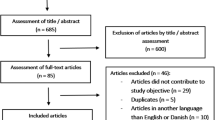Abstract
Design:
An age- and gender-matched case–control study.
Objective:
To compare colonoscopy after spinal cord injury (SCI) with the general population in terms of indications, bowel preparation, technical success and disease detection.
Setting:
Victoria, Australia.
Methods:
Consecutive SCI colonoscopies between January 1998 and February 2013 were compared with a randomly selected age- and gender-matched control group. Injury level, indication for procedure and demographics were collected. Outcome measures included quality of bowel preparation, completion rates, procedural duration and benign and malignant disease detection.
Results:
A total of 440 colonoscopies were assessed, comprising 148 SCI patients and 292 age- and gender-matched controls. Both the groups were of similar age (54.7 years vs 54.5 years, P=0.906) and comprised predominantly males (87.1% vs 86.3%, P=0.919). SCI colonoscopies were more often performed to investigate abnormalities (85.1% vs 58.2%, P<0.001) than for screening or surveillance (18.2% vs 40.8%, P<0.001). Unsatisfactory bowel preparation was recorded more often in the SCI group (36.0% vs 13.0%, P<0.001) and completion rates were lower (75.7% vs 93.1%, P<0.001). Overall disease detection was lower in the SCI group (45.3% vs 59.6%, P<0.006). The polyp detection rate was lower for SCI (11.4% vs 25.3%, P=0.001). The rate of diagnosis of malignancy was equivalent (2.7% vs 3.0%, P=0.904).
Conclusion:
SCI patients have the same risk of malignancy as the general population and are less likely to undergo screening colonoscopy. Colonoscopy is then limited by poor bowel preparation and lower completion rates with a subsequent lower polyp detection rate.
Similar content being viewed by others
Introduction
There is both an increasing prevalence and increasing average age of SCI patients.1 Despite improvements in acute mortality, there is still a decreased life expectancy now most frequently attributed to cancer.2 Colorectal cancer (CRC) screening in this group has received little attention despite reports of an at least equivalent cancer risk3, 4, 5 and presentation with more advanced disease.6
Detection of occult neoplastic disease is difficult due to higher rates of gastrointestinal complaints6, 7 and the high frequency of PR bleeding should exclude SCI patients from faecal occult blood testing.3
Colonoscopy is challenging with difficulties in bowel preparation and low intubation rates despite multiday bowel preparation,3, 8, 9 and studies assessing yield and safety of colonoscopy after SCI3, 8 have been limited by a small sample size or lack of a control group. We seek to highlight the difficulties with colonoscopy after SCI using a noninjured control group but to emphasise its importance by demonstrating the rates of benign and malignant diseases.
Methods
An ICD-10 code search identified all patients with SCI who had colonoscopy or flexible sigmoidoscopy between January 1998 and February 2013. A prospectively entered endoscopic database was then accessed and computer-generated random numbers used to select an age- and gender-matched control group from the same period. Flexible sigmoidoscopies were then excluded if the original intent was for an abbreviated procedure. All procedures were included if the intent had been for a complete colonoscopy regardless of outcome.
SCI patients were admitted through the spinal unit for a standardised bowel preparation of twice daily administration of oral sodium phosphate over 3.5 days and rectal sodium phosphate the evening and morning prior to the procedure. The noninjured controls all had outpatient oral sodium phosphate or Glycoprep (Fresenius Kabi, Australia, NSW, Australia).
Similar to that described elsewhere,3 the quality of bowel preparation was dichotomised to allow comparison as either ‘satisfactory’ to encompass the descriptors, ‘good’, ‘adequate’ and ‘satisfactory’ or ‘unsatisfactory’, to include ‘poor’, ‘inadequate’ and ‘unsatisfactory’. A complete colonoscopy was indicated by caecal or terminal ileal intubation. Benign and malignant diagnoses were recorded. Immediate complications were sought on the endoscopic record. Ethics approval was granted by the regional ethics committee.
Statistics
An estimated sample size was calculated to give at least 80% power to detect a 20% difference in the quality of bowel preparation and completion rates, with an alpha error set at 0.05. Statistical analysis was performed using SigmaStat (Systat Software, San Jose, California). A two-tailed Student’s t-test was used to compare age and gender. The quality of bowel preparation, technical success and disease detection rates were compared using chi-square with Yate's correction for continuity. Malignancy detection rate was compared using Fisher's Exact test.
Results
There were 440 procedures identified, 119 SCI persons had 148 colonoscopies compared with 292 controls. The SCI group had a mean age of 54.7 (s.d.13.005, s.e.m.1.080) and 129 (87.1%) were male. The controls had a mean age of 54.5 (s.d.13.5, s.e.m. 0.790) and 252 (86.3%) were male. Student’s t-test confirmed the groups matched in age (P=0.906) and gender (P=0.919). Spinal injury neurological levels can be seen in Table 1.
The SCI group were more likely to undergo colonoscopy for a diagnostic indication (Table 2) than the controls (85.1% vs 58.2%, P<0.001) and less likely to have a screening or surveillance indication (18.2% vs 40.8%, P<0.001).
Bowel preparation was more likely to be unsatisfactory in the SCI group (36.0% vs 13.0%, P<0.001). The completion rate was lower in the SCI group (76% vs 93%, P<0.001). Incomplete colonoscopy was most commonly due to poor preparation and looping in both groups (Table 3).
There was no diagnosis recorded in 54.7% SCI procedures compared with 40.4% of controls (P<0.006). Haemorrhoids were the most common pathology in the SCI group (20.3% vs 9.6%, P=0.003) and diverticular disease the most common in the controls (4.1% vs 15.8%, P<0.001) (Table 4).
The polyp detection rate was lower in the SCI group (11.4% vs 25.3%, P=0.001) but there was no difference in malignancy (2.7% vs 3.0%, P=0.907).
The total duration of procedure and withdrawal times were absent from the majority of reports and not further analysed. There were no immediate complications recorded in either group.
Discussion
The prevalence of SCI in Australia may increase to nearly 12 000 by the year 2021,1 a trend partly due to a decrease in acute mortality.2, 10 An ageing background population and an independent increase in age at the time of injury account for a proportional increase in older patients with SCI.1, 10 An expected increase in the incidence of age-related conditions requires a focus on chronic and preventative healthcare.
Overall, cancer is the most common cause of late mortality after SCI.2 In Australia, the general population has a 1 in 21 lifetime incidence of colorectal cancer11 and while an early study suggested an increased risk of CRC in SCI,12 our study supports the more recent notion of an equivalent cancer risk.3, 4, 5 SCI patients have increased obesity and physical inactivity as CRC risk factors,13 a tendency for a more advanced stage of malignancy at diagnosis6 and an increased risk of complications in the treatment of established cancer,14 thus further emphasising the need for screening and investigation of symptoms.
Multiple barriers limit the uptake of preventative healthcare measures in SCI patients.13, 15 Established CRC population screening guidelines are of limited utility given the high frequency of gastrointestinal complaints.7 Clinical examination is challenging, resource-dependant, unreliable16 and insufficient to exclude CRC. The occurrence of rectal bleeding in the majority should preclude the use of faecal occult blood test as a screening test.3 Computed tomographic colonography still requires bowel preparation, is inaccurate for lesions <1 cm11 and has not adequately been assessed in this population. Flexible sigmoidoscopy is arguably inadequate given high rates of proximal tumours.3, 12 Currently, only a minority of SCI patients undergo true screening colonoscopy15 and is likely to be performed for a diagnostic purpose, that is, to investigate symptoms, anaemia or other abnormalities (Table 2).
Despite an equivalent risk of malignancy, we have reported a lower polyp detection rate after SCI than in age-matched controls (Table 4). In the absence of a plausible protective mechanism against neoplasia, we consider this a surrogate marker for poor bowel preparation in this group. A high-quality colonoscopy requires effective bowel preparation to decrease the rate of missed adenomas.17, 18 Indeed, a 40% polyp detection rate published elsewhere after excluding those with initially unsatisfactory preparations emphasises the equivalent prevalence of neoplasia, the importance of an adequate preparation and the means to facilitate a repeat procedure.3 Poor bowel preparation was also the main reason for the more frequent failure to complete a colonoscopy (Table 3), and is known to increase the procedural difficulty and duration of procedure.17 Of concern is the prediction that an increased adenoma miss rate portends an increase in interval and perhaps later stage cancers, but this has not yet been seen in our series.
The alterations in autonomic tone impair colonic transit9, 19 and make effective cleansing of the colon difficult.8, 20 To our knowledge, there is no published regime that can be considered satisfactory, and the use of a hyperosmolar agent alone is inadequate. Acknowledging concerns of acute phosphate nephropathy following oral sodium phosphate,8 we are trialling a new regime based on two days of sodium picosulfate+magnesium+citrate (Fresenius Kabi) and a phosphate enema the morning of the procedure.
There is a paucity of literature addressing the prevalence of other benign diseases in SCI patients. Despite the prevalence of symptoms, we recorded a lower rate of benign diseases overall compared with controls. Two small comparative series had not previously demonstrated a difference between groups.4, 5 Haemorrhoids are much more common in SCI and the most frequent explanation for peri-rectal bleeding. Their occurrence is likely the consequence of altered anorectal tone permitting prolapse and/or the repeated trauma of digital stimulation to achieve evacuation.7 An increased rate of melanosis coli is also predictable given the chronic laxative requirements in this population.7, 19 To our knowledge, this is the first series to demonstrate a lower rate of diverticular disease in SCI patients and is in contradistinction to previous reports of equivalent or increased prevalence4, 5 due to higher intracolonic pressures.19
The major limitations of this study relate to the retrospective nature of the review. Although the data was entered prospectively, there was no specific education to ensure consistency and comparison. Some duplicity in the indications reflects actual practice, where it is difficult to allocate strictly to either a screening or diagnostic category. Without prospective adherence to a prescribed bowel preparation quality classification system, we assigned binary variables as to whether or not bowel preparation could be considered satisfactory. A pitfall is that the bowel preparation regimes differed across the two groups, but any future comparisons should be compared within or across spinal cord injured groups, a task which will require collaboration with other spinal injury units. Although we recorded no immediate complications and there is a potential for missed or delayed complications, the procedure is still considered safe.3
In attempting to delineate the spectrum of benign disease, it became apparent that there may be a degree of underreporting of benign disease, and in particular, the incidence of haemorrhoids is likely even higher in the SCI group. This may account for the lower rate of benign diseases overall and the difference found in identifying diverticulosis and could be prospectively assessed.
Although difficulties with the quality of bowel preparation and completion rates have been described previously, screening and colonoscopy after SCI has still not garnered sufficient attention nor resources given the now known comparable CRC risk. The use of colonoscopy as a screening tool and to investigate symptoms must be emphasised. We have effectively demonstrated that there remain quantifiable discrepancies in terms of the quality of bowel preparation and polyp detection despite more intensive bowel preparation attempts and there needs urgent attention to prove a safe, efficient and effective bowel preparation regime for the SCI group as a whole, and perhaps in time a tailored regimen based on bowel dysmotility patterns associated with the level and type of neurological injury.
Conclusion
As the spinal cord injury population gets older, there needs to be attention to preventative healthcare strategies. SCI patients have a similar risk of colorectal cancer but are precluded from noninvasive screening due to the prevalence of symptoms and rectal bleeding. Given the limitations of clinical assessment, colonoscopy should be performed at regular intervals; however, whilst it can be considered safe, it is not without difficulties. There is no current optimal bowel preparation regimen, with subsequent lower completion and polyp detection rates. Colonoscopy should be encouraged but bowel preparation regimes need urgent attention to improve polyp detection rates and help prevent the incidence of colorectal cancer.
Data Archiving
There were no data to deposit.
References
O'Connor PJ . Prevalence of spinal cord injury in Australia. Spinal Cord 2004; 43: 42–46.
Middleton JW, Dayton A, Walsh J, Rutkowski SB, Leong G, Duong S . Life expectancy after spinal cord injury: a 50-year study. Spinal Cord 2012; 50: 803–811.
Hayman AV, Guihan M, Fisher MJ, Murphy D, Anaya BC, Parachuri R et al. Colonoscopy is high yield in spinal cord injury. J Spinal Cord Med 2013; 36: 436–442.
Han SJ, Kim CM, Lee JE, Lee TH . Colonoscopic lesions in patients with spinal cord injury. J Spinal Cord Med 2009; 32: 404–407.
Rabadi MH, Vincent AS . Colonoscopic lesions in veterans with spinal cord injury. J Rehabil Res Dev 2012; 49: 257.
Stratton MD, McKirgan LW, Wade TP, Vernava AM, Virgo KS, Johnson FE et al. Colorectal cancer in patients with previous spinal cord injury. Dis Colon Rectum 1996; 39: 965–968.
Lynch AC, Wong C, Anthony A, Dobbs BR, Frizelle FA . Bowel dysfunction following spinal cord injury: a description of bowel function in a spinal cord-injured population and comparison with age and gender matched controls. Spinal Cord 2000; 38: 717–723.
Ancha HR, Spungen AM, Bauman WA, Rosman AS, Shaw S, Hunt KK et al. Clinical trial: the efficacy and safety of routine bowel cleansing agents for elective colonoscopy in persons with spinal cord injury—a randomized prospective single-blind study. Aliment Pharmacol Ther 2009; 30: 1110–1117.
Singal AKA, Rosman ASA, Bauman WAW, Korsten MAM . Recent concepts in the management of bowel problems after spinal cord injury. Adv Med Sci 2005; 51: 15–22.
DeVivo MJ . Sir Ludwig Guttmann Lecture: trends in spinal cord injury rehabilitation outcomes from model systems in the United States: 1973–2006. Spinal Cord 2007; 45: 713–721.
AIHW & AACR 2012. Cancer in Australia: an overview 2012. Cancer series no. 74. Cat. no. CAN 70. AIHW: Canberra, ACT, Australia.
Frisbie JH, Chopra S, Foo D, Sarkarati M . Colorectal carcinoma and myelopathy. J Am Paraplegia Soc 1984; 7: 33–36.
Lavela SL, Weaver FM, Smith B, Chen K . Disease prevalence and use of preventive services: comparison of female veterans in general and those with spinal cord injuries and disorders. J Womens Health (Larchmt) 2006; 15: 301–311.
Singh RK, Dharmasena D, Virgo KS, Tyson SE, Grossmann EM, Johnson FE . Proctectomy for rectal cancer in patients with prior spinal cord injury. Surg Oncol 2008; 17: 313–316.
Johnston MV, Diab ME, Chu B-C, Kirshblum S . Preventive services and health behaviors among people with spinal cord injury. J Spinal Cord Med 2004; 28: 43–54.
Longo WE, Ballantyne GH, Modlin IM . Colorectal disease in spinal cord patients. An occult diagnosis. Dis Colon Rectum 1990; 33: 131–134.
Froehlich F, Wietlisbach V, Gonvers J-J, Burnand B, Vader J-P . Impact of colonic cleansing on quality and diagnostic yield of colonoscopy: the European Panel of Appropriateness of Gastrointestinal Endoscopy European multicenter study. Gastrointest Endosc 2005; 61: 378–384.
Lebwohl B, Kastrinos F, Glick M, Rosenbaum AJ, Wang T, Neugut AI . The impact of suboptimal bowel preparation on adenoma miss rates and the factors associated with early repeat colonoscopy. Gastrointest Endosc 2011; 73: 1207–1214.
Lynch AC, Frizelle FA . Colorectal motility and defecation after spinal cord injury in humans. Prog Brain Res 2006; 152: 335–343.
Barber DB, Rogers SJ, Chen JT, Gulledge DE, Able AC . Pilot evaluation of a nurse-administered carepath for successful colonoscopy for persons with spinal cord injury. SCI Nurs 1999; 16: 14–15, 20.
Acknowledgements
We thank Professor Neville D Yeomans, Office for Research, Austin Hospital, Victoria for providing statistical assistance and Dr Alayne Moreira for the additional collection of data.
Author information
Authors and Affiliations
Corresponding author
Ethics declarations
Competing interests
The authors declare no conflict of interest.
Rights and permissions
About this article
Cite this article
Morris, B., Kucchal, T. & Burgess, A. Colonoscopy after spinal cord injury: a case–control study. Spinal Cord 53, 32–35 (2015). https://doi.org/10.1038/sc.2014.164
Received:
Revised:
Accepted:
Published:
Issue Date:
DOI: https://doi.org/10.1038/sc.2014.164
This article is cited by
-
Primary Care in the Spinal Cord Injury Population: Things to Consider in the Ongoing Discussion
Current Physical Medicine and Rehabilitation Reports (2023)
-
Similar Adenoma Detection Rates in Colonoscopic Procedures of Patients with Spinal Cord Injury Compared to Controls
Digestive Diseases and Sciences (2020)
-
Colorectal cancer screening in patients with spinal cord injury yields similar results to the general population with an effective bowel preparation: a retrospective chart audit
Spinal Cord (2018)
-
Bowel Dysfunction in Spinal Cord Injury
Current Gastroenterology Reports (2018)



